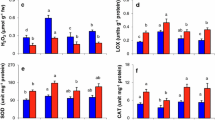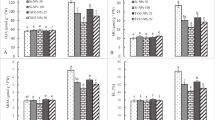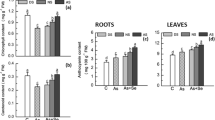Abstract
Arsenic (As) is a toxic element for plants, animals and humans. The mitigation of As stress has been achieved via selenium (Se) and silica (Si) supplementations. However, the effects of combined application of Se and Si against As stress are not known. The present study was conducted to evaluate the effect of Se (0.5 and 1 mg L−1) and Si (10 and 30 mg L−1) on Oryza sativa L. (rice) subjected to during As (4 mg L−1) stress. The rice plants showed reduction in As accumulation in co-treatment of As + Se, As + Si and As + Se + Si in comparison to As alone treated plants (7 d). The maximum reduction of As accumulation in root and shoot was 57% and 64%, respectively in As + Se + Si treatment. The increase in enzymatic antioxidant system (superoxide dismutase, ascorbate peroxidase, glutathione peroxidase, glutathione reductase and glutathione-s-transferase) along with decrease in oxidative stress markers (lipid peroxidation, dehydroascorbate reductase, ascorbate oxidase and hydrogen peroxide) in As + Se + Si treatment as compared to As treatment signified elevated tolerance of rice plants to As stress. Gene expressions of enzymes involved in antioxidant defence and thiol metabolism were found to be significantly positively correlated with their respective biochemical activities. In conclusion an optimum combination of Se and Si can be used to effectively mitigate As toxicity in plants.







Similar content being viewed by others
References
Afton SE, Catron B, Caruso JA (2009) Elucidating the selenium and arsenic metabolic pathways following exposure to the non-hyper accumulating Chlorophytum comosum, spider plant. J Exp Bot 60:1289–1297
Alam MZ, Hoque MA, Ahammed GJ, Carpenter-Boggs L (2019) Arbuscular mycorrhizal fungi, selenium, sulfur, silica-gel and biochar reduce arsenic uptake in plant biomass and improve nutritional quality in Pisum sativum. BioRxiv 663120.
Awasthi S, Chauhan R, Srivastava S, Tripathi RD (2017) The journey of arsenic from soil to grain in rice. Front Plant Sci 8:1007
Beauchamp C, Fridovich Y (1971) Superoxide dismutase: improved assays and an assay applicable to acrylamide gels. Anal Biochem 44:276–287
Bhadwal S, Sharma S (2022) Selenium alleviates physiological traits, nutrient uptake and nitrogen metabolism in rice under arsenate stress. Environ Sci Poll Res 29:70862–70881
Blaszczyk A, Sirko L, Hawkesford MJ, Sirko A (2002) Biochemical analysis of transgenic tobacco lines producing bacterial serine acetyl transferase. Plant Sci 162:589–597
Boorboori MR, Gao Y, Wang H, Fang C (2021) Usage of Si, P, Se, and Ca Decrease arsenic concentration/toxicity in rice, a review. Applied Sci 11(17):8090
Bradford MM (1976) A dye binding assay for protein. Anal Biochem 72:248–254
Chakraborty A, Ghosh S, Biswas B, Pramanik S, Nriagu J, Bhowmick S (2022) Epigenetic modifications from arsenic exposure: a comprehensive review. Sci Total Environ 810:151218
Cooper AM, Felix D, Alcantara F, Zaslavsky I, Work A, Watson PL, Pezzoli K, Yu Q, Zhu D, Scavo AJ, Zarabi Y (2020) Monitoring and mitigation of toxic heavy metals and arsenic accumulation in food crops: a case study of an urban community garden. Plant Direct 4(1):e00198
Coskun D, Britto DT, Huynh WQ, Kronzucker HJ (2016) The role of silicon in higher plants under salinity and drought stress. Front Plant Sci 7:1072
Das S, Biswas AK (2022) Comparative study of silicon and selenium to modulate chloroplast pigments levels, Hill activity, photosynthetic parameters and carbohydrate metabolism under arsenic stress in rice seedlings. Environ Sci Poll Res 29(13):19508–19529
Das S, Majumder B, Biswas AK (2022) Comparative study on the influence of silicon and selenium to mitigate arsenic induced stress by modulating TCA cycle, GABA, and polyamine synthesis in rice seedlings. Ecotoxicol 31(3):468–489
De Tullio MC, De Gara L, Paciolla C, Arrigoni O (1998) Dehydroascorbate reducing proteins in maize are induced by the ascorbate biosynthesis inhibitor lycorine. Plant Physiol Biochem 36:433–440
Devi SR, Prasad MNV (1998) Copper toxicity in Ceratophyllum demersum L. (Coontail), a free floating macrophyte: response of antioxidant enzymes and antioxidants. Plant Sci 138:157–165
Dixit G, Singh AP, Kumar A, Singh PK, Kumar S, Dwivedi S, Trivedi PK, Pandey V, Norton GJ, Dhankher OP, Tripathi RD (2015) Sulfur mediated reduction of arsenic toxicity involves efficient thiol metabolism and the antioxidant defense system in rice. J Hazard Mater 298:241–251
Drotar A, Phelps P, Fall R (1985) Evidence for glutathione peroxidase activities in cultured plant cell. Plant Sci 42:35–40
Dubey AK, Kumar N, Ranjan R, Gautam A, Pande V, Sanyal I, Mallick S (2018) Application of glycine reduces arsenic accumulation and toxicity in Oryza sativa L. by reducing the expression of silicon transporter genes. Ecotoxicol Environ Saf 148:410–417
Dwivedi S, Tripathi RD, Tripathi P, Kumar A, Dave R, Mishra S, Singh R, Sharma D, Rai UN, Chakrabarty D, Trivedi PK (2010) Arsenate exposure affects amino acids, mineral nutrient status and antioxidants in rice (Oryza sativa L.) genotypes. Environ Sci Technol 44(24):9542–9549
Dwivedi S, Kumar A, Mishra S, Sharma P, Sinam G, Bahadur L, Goyal V, Jain N, Tripathi RD (2020) Orthosilicic acid (OSA) reduced grain arsenic accumulation and enhanced yield by modulating the level of trace element, antioxidants, and thiols in rice. Environ Sci Poll Res 27(19):24025–24038
Esaka M, Imagi J, Suzuki K (1988) Formation of ascorbate oxidase in cultured pumpkin cells. Plant Cell Physiol 29:231–235
Feng R, Wei C, Tu S, Sun X (2009) Interactive effects of selenium and arsenic on their uptake by Pteris vittata L under hydroponic conditions. Environ Ex Bot 65:363–368
Gaitonde MK (1967) Spectrophotometric method for the direct determination of cysteine in the presence of other naturally occurring amino acids. Biochem J 104:627–633
Gao Z, Tang X, Ye M, Gul I, Chen H, Yan G, Chang SX, Liang Y (2021) Effects of silicon on the uptake and accumulation of arsenite and dimethylarsinic acid in rice (Oryza sativa L.). J Hazard Mater 409:124442
Gupta K, Srivastava A, Srivastava S, Kumar A (2020) Phyto-genotoxicity of arsenic contaminated soil from Lakhimpur Kheri India on Vicia faba L. Chemosphere 241:125063
Gupta K, Srivastava S, Saxena G, Kumar A (2022) Application of Pteris vittata . for phytoremediation of arsenic and biomonitoring of the process through cyto-genetic biomarkers of Trigonella foenum-graecum L. Physiol Mol Biol Plants 28(1):91–106
Habig WH, Jacoby WB (1981) Assay for differentiation of glutathione S-transferases. Meth Enzymol 77:398–405
Heath RL, Packer L (1968) Photoperoxidation in isolated chloroplast I. Kinetic and stoichiometry of fatty acid peroxidation. Arch Biochem Biophys 125:189–198
Hemeda HM, Klein BP (1990) Effects of naturally occurring antioxidants on peroxidase activity of vegetable extracts. J Food Sci 55:184–192
Ismail LM, Soliman MI, Abd El-Aziz MH, Abdel-Aziz HM (2022) Impact of silica ions and nano silica on growth and productivity of pea plants under salinity stress. Plants 11(4):494
Jaishankar M, Tseten T, Anbalagan N, Mathew BB, Beeregowda KN (2014) Toxicity, mechanism and health effects of some heavy metals. Interdiscip Toxicol 7(2):60–72
Khan MIR, Jahan B, AlAjmi MF, Rehman MT, Iqbal N, Irfan M, Sehar Z, Khan NA (2021) Crosstalk of plant growth regulators protects photosynthetic performance from arsenic damage by modulating defense systems in rice. Ecotoxicol Environ Saf 222:112535
Khush Gurdev S (2013) Strategies for increasing the yield potential of cereals: case of rice as an example. Plant Breeding 132(5):433–436
Kumar N, Mallick S, Yadava RN, Singh AP, Sinha S (2013) Co-application of selenite and phosphate reduces arsenite uptake in hydroponically grown rice seedlings: toxicity and defence mechanism. Ecotox Environ Safety 91:171–179
Kumar A, Tripathi RD, Singh RP, Dwivedi S, Chakrabarty D, Mallick S, Trivedi PK, Adhikari B (2014) Evaluation of amino acid profile in contrasting arsenic accumulating rice (Oryza sativa L.) genotypes under arsenic stress grown in hydroponic condition. Biologia Plantarum 58(4):733–742
Kumar A, Tripathi RD, Singh RP, Singh PK, Awasthi S, Trivedi PK, Chakrabarty D (2014) Selenium ameliorates arsenic induced oxidative stress through modulation of antioxidant enzymes and thiols in rice (Oryza sativa L.). Ecotoxicol 23(7):1153–1163
Kumar A, Dixit G, Singh AP, Srivastava S, Mishra K, Tripathi RD (2016) Selenate mitigates arsenite toxicity in rice (Oryza sativa L.) by reducing arsenic uptake and ameliorates amino acid content and thiol metabolism. Ecotoxicol Environ Saf 133:350–359
Kumar A, Singh PK, Srivastava S, Dwivedi S, Tripathi RD, Awasthi G, Gupta K, Ansari MI (2020) A comparative study on effect of arsenic on thiolic ligands and phytochelatins in contrasting arsenic accumulating rice genotypes. Internat J Plant Environ 6(02):110–117
Lange CN, Pedron T, Freire BM, Pereira RM, Batista BL (2020) Arsenic in rice grain. In the future of rice demand quality beyond productivity. Springer, Cham, pp 71–91
Liu WJ, Zhu YG, Smith FA, Smith SE (2004) Do iron plaque and genotypes affect arsenate uptake and translocation by rice seedlings (Oryza sativa L.) Grown in solution culture. J Exp Bot 55:1707–1713
Ma JF, Tamai K, Yamaji N, Mitani N, Konishi S, Katsuhara M, Ishiguro M, Murata Y, Yano M (2006) A silicon transporter in rice. Nature 440:688–691
Ma JF, Yamaji N, Mitani N, Xu XY, Su YH, McGrath SP, Zhao F (2008) Transporters of arsenite in rice and their role in arsenic accumulation in rice grain. Proc Natl Acad Sci USA 105:9931–9935
Malik JA, Goel S, Kaur N, Sharma S, Singh I, Nayyar H (2012) Selenium antagonises the toxic effects of arsenic on mungbean (Phaseolus aureus Roxb.) plants by restricting its uptake and enhancing the antioxidative and detoxification mechanisms. Environ Exp Bot 77:242–248
Mitra A, Chatterjee S, Gupta DK (2020) Environmental arsenic exposure and human health risk. In arsenic water resources contamination. Springer, Cham, p 103e129
Moulick D, Ghosh D, Santra SC (2016) Evaluation of effectiveness of seed priming with selenium in rice during germination under arsenic stress. Plant Physiol Biochem 109:571–578
Moulick D, Ghosh D, Mandal J, Bhowmick S, Mondal D, Choudhury S, Santra SC, Vithanage M, Biswas JK (2023) A cumulative assessment of plant growth stages and selenium supplementation on arsenic and micronutrients accumulation in rice grains. J Clean Prod 386:135764
Nakano Y, Asada K (1981) Hydrogen peroxide is scavenged by ascorbate specific peroxidase in spinach chloroplasts. Plant Cell Physiol 22:867–880
Pan D, Liu C, Yi J, Li X, Li F (2021) Different effects of foliar application of silica sol on arsenic translocation in rice under low and high arsenite stress. J Environ Sci 105:22–32
Pandey C, Gupta M (2018) Selenium amelioration of arsenic toxicity in rice shows genotypic variation: a transcriptomic and biochemical analysis. J Plant Physiol 231:168–181
Rai A, Tripathi P, Dwivedi S, Dubey S, Shri M, Kumar S, Tripathi PK, Dave R, Kumar A, Singh R, Adhikari B, Bag M, Tripathi RD, Trivedi PK, Chakrabarty D, Tuli R (2011) Arsenic tolerances in rice (Oryza sativa L.) have a predominant role in transcriptional regulation of a set of genes including sulphur assimilation pathway and antioxidant system. Chemosphere 82:986–995.
Rosen BP, Liu Z (2009) Transport pathways for arsenic and selenium: a mini-review. Environ Internat 35:512–515
Sahay S, Khan E, Praveen A, Panthri M, Mirza Z, Gupta M (2020) Sulphur potentiates selenium to alleviate arsenic-induced stress by modulating oxidative stress, accumulation and thiol-ascorbate metabolism in Brassica juncea L. Environ Sci Poll Res 27(11):11697–11713
Saito K, Kurosawa M, Tatsuguchi K, Takagi Y, Murakoshi I (1994) Modulation of cysteine biosynthesis in chloroplasts of transgenic tobacco overexpressing cysteine synthase [O-Acetylserine(thiol)-lyase]. Plant Physiol 106:887–895
Sarma BK, Mugesh G (2008) Thiol cofactors for selenoenzymes and their synthetic mimics. Org Biomol Chem 6(6):965–974
Scandalios JG, Tsaftaris AS, Chandlee JM, Skadsen RW (1983) Expression of the developmentally regulated catalase (Cat) genes in maize. Dev Genet 4(4):281–293
Seelig GF, Meister A (1984) γ-glutamyl cysteine synthetase: interactions of an essential sulfhydryl group. J Biol Chem 259:3534–3538
Singh PK, Chakrabarty D, Dwivedi S, Kumar A, Singh SP, Sinam G, Niranjan A, Singh PC, Chatterjee S, Majumdar D, Tiwari M (2022) Nitric oxide-mediated alleviation of arsenic stress involving metalloid detoxification and physiological responses in rice (Oryza sativa L.). Environ Poll 297:118694
Srivastava S, Akkarakaran JJ, Sounderajan S, Shrivastava M, Suprasanna P (2016) Arsenic toxicity in rice (Oryza sativa L.) is influenced by sulfur supply: Impact on the expression of transporters and thiol metabolism. Geoderma 270:33–42
Srivastava S, Mishra S, Tripathi RD, Dwivedi S, Gupta DK (2006) Copper induced oxidative stress and responses of antioxidants and phytochelatins in Hydrilla verticillata (L.f.) Royle. Aquat Toxicol 80:405–415
Srivastava S, Pathak S, Ponsin M, Hensawang S, Chanpiwat P, Yoeurn C, Phan K (2022) Sustainable solutions to arsenic accumulation in rice grown in south and south-east Asia. Crop Pasture Sci 73:149–159
Tiwari M, Kidwai M, Dutta P, Narayan S, Gautam N, Chawda K, Shirke PA, Mishra AK, Chakrabarty D (2022) A tau class glutathione-S-transferase (OsGSTU5) confers tolerance against arsenic toxicity in rice by accumulating more arsenic in root. J Hazard Mater 426:128100
Tripathi P, Tripathi RD, Singh RP, Dwivedi S, Goutam D, Shri M, Trivedi PK, Chakrabarty D (2013) Silicon mediates arsenic tolerance in rice (Oryza sativa L.) through lowering of arsenic uptake and improved antioxidant defence system. Ecol Eng 52:96–103
Upadhyay MK, Majumdar A, Srivastava AK, Bose S, Suprasanna S, Srivastava S (2022) Antioxidant enzymes and transporter genes mediate arsenic stress reduction in rice (Oryza sativa L.) upon thiourea supplementation. Chemosphere 292:133482
Yadav B, Jogawat A, Gnanasekaran P, Kumari P, Lakra N, Lal SK, Pawar J, Narayan OP (2021) An overview of recent advancement in phytohormones-mediated stress management and drought tolerance in crop plants. Plant Gene 25:100264
Yang Y, Hu H, Fu Q, Zhu J, Zhang X, Xi R (2020) Phosphorus regulates As uptake by rice via releasing As into soil pore water and sequestrating it on Fe plaque. Sci Tot Environ 738:139869
Zhang J, Duan GL (2008) Genotypic difference in arsenic and cadmium accumulation by rice seedlings grown in hydroponics. J Plant Nut 31:2168–2182
Acknowledgements
The authors are thankful to Botany Department, Lucknow University, Lucknow for the facilities. Amit Kumar is thankful to SERB, DST, New Delhi for the award and financial assistance in form of SERB-NPDF.
Author information
Authors and Affiliations
Contributions
AK performed experimental work, prepared figures and writing original draft. SS, MIA and KG- writing, review & editing. AB and PKS helped in biochemical analysis. All authors have read and approved the manuscript.
Corresponding authors
Ethics declarations
Conflict of interest
The authors declare that they have no conflict of interest.
Additional information
Handling Editor: Anket Sharma.
Publisher's Note
Springer Nature remains neutral with regard to jurisdictional claims in published maps and institutional affiliations.
Supplementary Information
Below is the link to the electronic supplementary material.
Rights and permissions
Springer Nature or its licensor (e.g. a society or other partner) holds exclusive rights to this article under a publishing agreement with the author(s) or other rightsholder(s); author self-archiving of the accepted manuscript version of this article is solely governed by the terms of such publishing agreement and applicable law.
About this article
Cite this article
Kumar, A., Ansari, M.I., Singh, P.K. et al. Synergistic Effects of Selenium and Silicon Mitigate Arsenic Toxicity in Oryza sativa L.. J Plant Growth Regul 43, 1272–1286 (2024). https://doi.org/10.1007/s00344-023-11182-x
Received:
Accepted:
Published:
Issue Date:
DOI: https://doi.org/10.1007/s00344-023-11182-x




